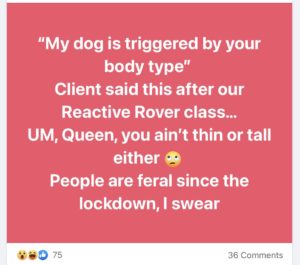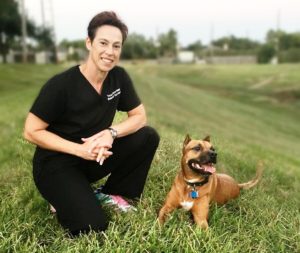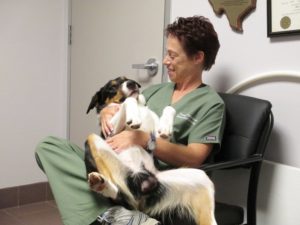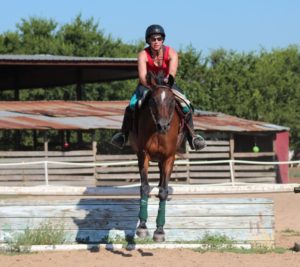Michael Baugh CDBC CPDT-KSA
We’ve come full circle. Good dog trainers have always known that teaching is about relationships. It’s not so much “leadership,” (Do it or else). It’s more about cooperation (Let’s work on this together). We’ve known this even though for a while it looked like we forgot.
To some extent or another, too many of us became fix-it trainers. Dogs became a list of problems to solve. Our business coaches told us that’s what clients wanted–results, nothing more. We knew they were wrong, but we changed our business plans and turned our web sites over to them (at no small cost). And fix-it we did. We stopped the crummy behavior from happening and taught the shiny new behavior instead. We packaged it up as solutions and modifications, like we were tricking out cars. All the while, we still knew. This is about the relationship, silly. The human, the dog, the team.
It’s all come full circle. Relationships are the thing again, and rightly so. Maybe it was Covid. I learned a whole new way of living with my dogs, as you probably did too. It drew us closer. It taught us new lessons. Deeper ones, I think.
 Take notice. The world slowed down, at least a little, at least for a little while. I could (and did) spend hours just watching my dogs. There was time to notice what they paid attention to. I saw what they did more often and in greater detail. I even watched them sleep. And here’s the other thing. I noticed them noticing me. They watch us, follow us, and listen to us far more than we give them credit for.
Take notice. The world slowed down, at least a little, at least for a little while. I could (and did) spend hours just watching my dogs. There was time to notice what they paid attention to. I saw what they did more often and in greater detail. I even watched them sleep. And here’s the other thing. I noticed them noticing me. They watch us, follow us, and listen to us far more than we give them credit for.
Communicate. There have been several studies that suggest dogs understand our meaning far better than we understand theirs. They read our facial expressions, our voices, and even our casual gestures and accurately interpret our intent. We know this, if we are paying attention, because of how they respond. They have their own gestures and expressions. It’s been called a language of sorts, and we can learn it. This is the bedrock of training, mastering the give and take, the quid pro quo, the rap-and-riff of our interactions with dogs. It’s like good improv. A little something from me, a little something from you. A conversation.
Turn towards, not away. All we have to do is to lean into this truth. Dog training is not a top-down endeavor. It’s a back-and-forth. Our dogs have intention. They are thinking and feeling. Psychologist John Gottman taught this concept in marriage. When our partner reaches out (Gottman calls this a “bid”), the more we turn toward them to engage and exchange, the richer our marriage will become. There is a parallel here for all relationships, including the learning relationship we have with our non-human friends. Your dog, I guarantee it, is always bidding. He’s exploring his agency in the world, gambling, engaging, experimenting. Turn towards that behavior, towards your dog, not away from it. Connect. Collaborate. Build shared understanding. Add fluidity to learning. Create trust.
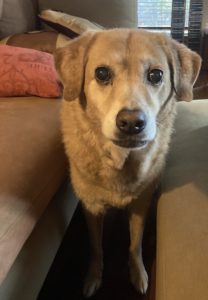 This is not ethereal pie-in-the-sky thinking. It’s foundational. There is certainly a time and a place for fixing problem behaviors. There’s a place for teaching cool skills and even tricks (tricking out your dog). If you’re focused on the results alone, though, you will struggle. In fact, often the struggle is all you will see. I wonder sometimes why it all feels so difficult. What if we saw our dog instead of the struggle, this other life in the room? What if we were open to the conversation? I see you and I smile and I know you know what that means. I see your bid–for attention, for engagement, for a chance to choose this or that. How could I miss it? You’re here, breathing and thinking and real.
This is not ethereal pie-in-the-sky thinking. It’s foundational. There is certainly a time and a place for fixing problem behaviors. There’s a place for teaching cool skills and even tricks (tricking out your dog). If you’re focused on the results alone, though, you will struggle. In fact, often the struggle is all you will see. I wonder sometimes why it all feels so difficult. What if we saw our dog instead of the struggle, this other life in the room? What if we were open to the conversation? I see you and I smile and I know you know what that means. I see your bid–for attention, for engagement, for a chance to choose this or that. How could I miss it? You’re here, breathing and thinking and real.
I turn toward you. How could I not, you delightful, crazy, adorable, sometimes problematic, dog?
Michael Baugh teaches dog training and behavior in Houston, TX. He specializes in aggressive dog behavior.


